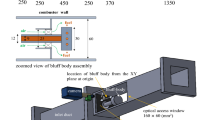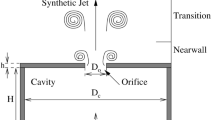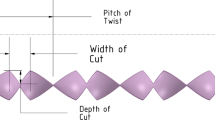Abstract
Lobe-forced mixer is one typical example of the passive flow controllers owing to its corrugated trailing edge. Besides the spanwise Kelvin–Helmholtz vortex shedding, streamwise vortices are also generated within its mixing layer. The geometrical configuration of the lobe significantly affects these two types of vortices, which in turn affects the mixing performance of the mixer. In the present investigation, characteristics of mixers with five different configurations were examined and evaluated for two velocity ratios (r = 1, 0.4). The mixers have only one lobe in order to eliminate any possible interactions between neighboring vortices generated by the adjacent lobes. Hot-wire anemometer was used to examine the Kelvin–Helmholtz vortices via the spectrum analysis while laser Doppler anemometer was employed to examine the streamwise vortices. It was found that there were two main frequencies for the Kelvin–Helmholtz vortices in the wake of the mixer; and the Strouhal numbers approached their respective maximum values at high Reynolds number. The rectangular mixer had similar mixing performance with the semicircular one; and both of them were better than the triangular mixer. The scalloping modification enhanced mixing by generating additional streamwise vortices while the scarfing modification could not improve the mixing performance.



















Similar content being viewed by others
Abbreviations
- A wake :
-
Wake area of the lobe-forced mixer flow (m2)
- C I :
-
Normalized streamwise circulation \( C_{\text{I} } = \frac{{\Upgamma_{I} }}{{\overline{U} \times \lambda }} \)
- R :
-
Radius of the semi-circle part of the lobe trailing edge (m)
- Re :
-
Reynolds number \( Re = \frac{{\rho \overline{U} \lambda }}{\mu } = \frac{{\overline{U} \lambda }}{\nu } \)
- St :
-
Strouhal number \( St = \frac{\lambda }{{\lambda_{\text{{K}\text{--} \text{H}}} }} = \frac{f \times \lambda }{{\overline{U} }} \)
- U 1 and U 2 :
-
Upper and lower stream velocity (m/s)
- \( \overline{U} \) :
-
Mean velocity (nominal velocity) \( \overline{U} = \frac{{U_{1} + U_{2} }}{2}, \) (m/s)
- \( \overline{U} ,\overline{V} ,\overline{W} \) :
-
Mean velocities in the streamwise, spanwise and traverse directions, respectively (m/s)
- \( u',v',w' \) :
-
rms (root-mean-square) velocities in the streamwise, spanwise and traverse directions, respectively (m/s)
- X, Y, Z :
-
Cartesian coordinate system (streamwise, spanwise and traverse directions accordingly)
- f :
-
Kelvin–Helmholtz vortex shedding frequency (Hz)
- h :
-
Height of the lobe (m)
- r :
-
Velocity ratio of the on-coming streams, \( r = \frac{{U_{1} }}{{U_{2} }} \)
- ΓI :
-
Mean streamwise circulation of the plane I, \( \Upgamma_{\text{I}} = \int\nolimits_{{\overrightarrow {\text{AB}} }} {\overline{V} \times {\text{d}}y} + \int\nolimits_{{\overrightarrow {\text{BC}} }} {\overline{W} \times {\text{d}}z} + \int\nolimits_{{\overrightarrow {\text{CD}} }} {\overline{V} \times {\text{d}}y} + \int\nolimits_{{\overrightarrow {\text{DA}} }} {\overline{W} \times {\text{d}}z} \)
- ε :
-
Penetration angle (half divergence angle) of the lobe-forced mixer
- λ:
-
Wavelength of the lobe (m)
- \( \lambda_{K - H} \) :
-
Average K–H vortex wavelength (m)
- ω :
-
vorticity \( \overrightarrow {\omega } = \nabla \times \overrightarrow {U} \)
- ω x :
-
Streamwise vorticity \( \overrightarrow {{\omega_{x} }} = (\frac{\partial W}{\partial y} - \frac{\partial V}{\partial z}) \times \overrightarrow {i} \)
- 1:
-
Upper stream
- 2:
-
Lower stream
- C:
-
Point C of the mixer trailing edge
- L:
-
Point L of the mixer trailing edge
References
Antonia RA, Rajagopalan S (1990) A comment on the determination of drag of a circular cylinder. AIAA J 28:1833–1835
Barber T, Paterson RW, Skebe SA (1988) Turbofan forced mixer lobe flow modeling, part 1: experimental and analytical assessment, NASA contractor report 4147
Bevilaqua PM (1978) Evaluation of hypermixing for thrust augmenting ejector. J Aerocraft 11(6):348–354
Cheng L, Zhou Y (2008) Surface perturbation technique for flow-induced vibration and noise control. J Sound Vib 310:527–540
Crouch RW, Coughlin CL, Paynter GC (1976) Nozzle exit flow profile shaping for jet noise reduction, AIAA paper, pp 76–511
Durst F, Melling A, Whitelaw JH (1981) Principals and practice of laser-Doppler anemometry. Academic Press, London
Eckerle WA, Sheibani H, Awad J (1992) Experimental measurement of the vortex development downstream of a lobed forced mixer. ASME J Eng Gas Turbines Power 114:63–71
Kuchar AP, Chamberlin R (1980) Scale model performance test investigation of exhaust system mixers for an energy efficiency engine (E3) propulsion system, AIAA paper, pp 80–229
Mao R (2005) Two-stream mixing flow with streamwise vorticity, PhD thesis, Nanyang Technological University, Singapore
Mao R, Yu SCM, Chua LP (2006) Kelvin–Helmholtz and streamwise vortices in the near wake of a single-lobe forced mixer. J Aero Eng Proc Inst Mech Eng Part G 220:279–298
McCormick DC, Bennett JC Jr (1994) Vortical and turbulent structure of a lobed mixer free shear layer. AIAA J 32(9):1852–1859
Moffat RJ (1988) Describing the uncertainties in experimental results. Exp Therm Fluid Sci 1:3–17
O’Sullivan MN, Krasnodebski JK, Waitz IA, Greitzer EM, Tan CS, Dawes WN (1996) Computational study of viscous effects on lobed mixer flow features and performance. AIAA J Prop Power 12(3):449
Paterson RW (1982) Turbofan forced mixer-nozzle internal flowfield. In: A benchmark experimental study, vol 1, NASA contractor report 3492
Povinelli LA, Anderson BH and Gerstenmaier W (1980) Computation of three dimensional flow in turbofan mixers and comparison with experimental data, AIAA paper, pp 80–227
Roshko A (1955) On the wake and drag of bluff bodies. J Aero Sci 22:124–135
Shumpert PK (1980) An experimental model investigation of turbofan engine internal exhaust gas mixer configurations, AIAA paper, pp 80–228
Skebe SA, McCormick DC, Presz WM (1988) Parameter effects on mixer-ejector pumping performance, AIAA paper, pp 88–188
Ukeiley L, Glauser M, Wick D (1993) Downstream evolution of proper orthogonal decomposition eigenfunctions in a lobed forced mixer. AIAA J 31(8):1392–1397
Waugh D (1992) The efficiency of symmetric vortex merger. Phys Fluids A 4:1745–1758
Yanta WJ, Smith RA (1973) Measurements of turbulence transport properties with a laser-Doppler velocimeter, AIAA paper, pp 73–169
Yu SCM, Xu XG (1998) Flow characteristics of confined coaxial nozzle flow with a central lobed mixer at different velocity ratios. AIAA J 36(3):349–358
Yu SCM, Xu XG, Yip TH (1995) Effects of initial boundary layers to the lobed mixer trailing Streamwise vorticity. AIAA J Prop Power 12(2):440–442
Yu SCM, Hou YX, Chan WK (2000) Effects of scalloping and scarfing to the mixing performances of lobed forced mixers. AIAA J Prop Power 16(3):440–448
Author information
Authors and Affiliations
Corresponding author
Rights and permissions
About this article
Cite this article
Mao, R., Yu, S.C.M., Zhou, T. et al. On the vorticity characteristics of lobe-forced mixer at different configurations. Exp Fluids 46, 1049–1066 (2009). https://doi.org/10.1007/s00348-009-0613-x
Received:
Revised:
Accepted:
Published:
Issue Date:
DOI: https://doi.org/10.1007/s00348-009-0613-x




